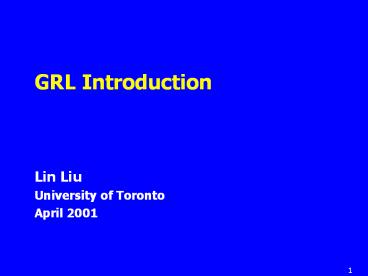GRL Introduction PowerPoint PPT Presentation
Title: GRL Introduction
1
GRL Introduction
- Lin Liu
- University of Toronto
- April 2001
2
Why Goal-Orientation??van Lamsweerde (ICSE 2000)
- Systematic derivation of requirements from goals
- Goals provide rationales for requirements
- Goal refinement structure provides a
comprehensible structure for the requirements
document - Alternative goal refinements and agent
assignments allow alternative system proposals to
be explored - Goal formalization allows refinements to be
proved correct and complete.
3
Where Are We??
object-oriented programming
GRL
KAOS
UCM
SDL
UML
Detailed design
Architectural design
Late requirements
Implementation
Mylopoulos AOIS99
4
Development-World model refers to and reasons
about
Alt-2
- Alt-1
To-be
As-is
Operational-World models
5
Outline
- 1. Goal-oriented modeling concepts in GRL
- 2. An example goal-oriented non-functional
requirement analysis process - 3. Combined use of goal and scenario from
requirement to architectural design - 4. Agent-oriented concepts in GRL
- 5. Related works
6
Goals and Softgoals in GRL
7
Tasks in GRL
8
Goal Refinement Means-ends Link
Task Refinement Decomposition Link
9
Softgoal Operationalizations Contribution
Relationship
Side-effects to softgoals Correlation
Relationship
10
Resource in GRL
11
Non-Intentional Elements in GRL
- Acting as parameters in GRL intentional elements,
i.e., topics of softgoal, Object attributes of
goal, task and belief - Referring to entities of an external model, such
as responsibilities in UCM, class/objects in UML
class diagram,
12
Belief in GRL
13
Outline
- 1. Goal-oriented modeling concepts in GRL
- 2. An example goal-oriented requirement analysis
process - 3. Combined use of goal and scenario from
requirement to architecture design - 4. Agent-oriented concepts in GRL
- 5. Related works
14
Softgoal Operationalization Example
15
Softgoal Operationalization Example (contd)
16
Example (contd)
17
Example (contd)
18
Outline
- 1. Goal-oriented modeling concepts in GRL
- 2. An example goal-oriented requirement analysis
process - 3. Combined use of goal and scenario from
requirement to architecture design - 4. Agent-oriented concepts in GRL
- 5. Related works
19
(No Transcript)
20
(No Transcript)
21
(No Transcript)
22
Goal model in GRL
23
An Original unbounded UCM scenario corresponding
to Goal Call Services Be Supported
24
Bounded UCM scenarios of Solutions Reside
VoiceCoder in (1) Base Station or (2) in Switch
25
Design Alternatives Their Contributions to NFRs
26
Outline
- 1. Goal-oriented modeling concepts in GRL
- 2. An example goal-oriented requirement analysis
process - 3. Combined use of goal and scenario from
requirement to architecture design - 4. Agent-oriented concepts in GRL
- 5. Related works
27
Agent-Orientation in GRL
- Actors are semi-autonomous, partially knowable
- Strategic actors, intentional dependencies
- Can be considered as goal-holders
Strategic Dependency Model
Meeting Scheduling Example
28
Revealing goals, finding alternatives
- Asking Why, How, How else
29
Scheduling meeting with meeting scheduler
- Consider
- Technology as enabler
- Networked systems and organizations
- Increased inter-dependency and vulnerability
- Limited knowledge and control
- Openness and uncertainties
- Cooperation
- Boundaries, locality, identity
30
Distributed Goal Model with Meeting Scheduler
- SR2
31
Outline
- 1. Goal-oriented modeling concepts in GRL
- 2. An example goal-oriented requirement analysis
process - 3. Combined use of goal and scenario from
requirement to architecture design - 4. Agent-oriented concepts in GRL
- 5. Related works
32
Goal-Oriented Requirements Engineering (GORE)
- GORE is gathering momentum
- CSD Feather 87
- KAOS van Lamsweerde,
- Inquiry Cycle Potts, Anton
- EKD Bubenko, Rolland, Loucopoulos
- Win-Win Boehm
- NFR Chung, Mylopoulos,
- Hopefully, MOMENTUM gtgtgt
- Z.URN proposal to ITU-T (Nov. 2000)
- GRL
33
Goal scenario in RE and in Architectural
Design
- Krutchens 41 model of software architecture
- Software Architecture Analysis Method (SAAM)
- Van Lamsweerde and Willement
- CREWS-LEcritoire approach of Collete Rolland et
al.
34
Resources regarding GRL
- Home of GRL
- http//www.cs.toronto.edu/km/GRL/
- Tool web site
- http//www.cs.toronto.edu/km/OME/
- References
- Chung, L., Nixon, B.A., Yu, E.and Mylopoulos, J.
Non-Functional Requirements in Software
Engineering. Kluwer Academic Publishers, 2000. - Yu, E. and Mylopoulos, J. Why Goal-Oriented
Requirements Engineering. In Proceedings of the
4th International Workshop on Requirements
Engineering Foundations of Software Quality.
June 1998, Pisa, Italy. E. Dubois, A.L. Opdahl,
K. Pohl, eds. Presses Universitaires de Namur,
1998. pp. 15-22. - Also at http//www.cs.toronto.edu/eric

